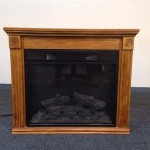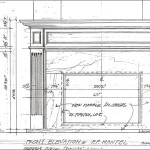How to Fix a Fireplace Damper
A fireplace damper is a crucial component in maintaining energy efficiency and preventing safety hazards within a home. Its primary function is to seal off the chimney flue when the fireplace is not in use, preventing drafts, heat loss in the winter, and unwanted pests or debris from entering the house. A malfunctioning damper can lead to significant energy waste and potentially dangerous situations. Therefore, understanding how to diagnose and fix common damper issues is essential for responsible homeownership. This article provides a comprehensive guide to troubleshooting and repairing a fireplace damper, covering various types of dampers and potential problems.
Prior to commencing any repair work on a fireplace damper, safety precautions are paramount. First, ensure the fireplace is completely cool. Never attempt to work on a damper immediately after using the fireplace, as residual heat could cause burns. Secondly, wear appropriate safety gear, including gloves and eye protection. The chimney and fireplace can contain soot, creosote, and other potentially harmful substances. A dust mask or respirator is also recommended to prevent inhalation of these particles. Finally, use caution when working at heights, especially if accessing the damper from the roof. A sturdy ladder and potentially a safety harness may be necessary, depending on the chimney's height and accessibility.
Identifying the Type of Fireplace Damper
The first step in fixing a fireplace damper is to identify its type. The most common types are throat dampers, top-sealing dampers, and cast iron dampers. Each type has its own characteristics and potential problems.
A throat damper is located just above the firebox, at the throat of the fireplace. It is typically operated by a lever or a poker that connects to a metal plate. Throat dampers are relatively inexpensive and easy to install, but they are not as effective at sealing the chimney as other types. They are also prone to rust and corrosion due to their proximity to heat and moisture.
A top-sealing damper, also known as a chimney top damper, is installed at the top of the chimney flue. It provides a much tighter seal than a throat damper, significantly reducing heat loss and preventing drafts. Top-sealing dampers are typically operated by a cable that runs down the chimney and attaches to a handle inside the firebox. Although more expensive than throat dampers, they offer superior energy efficiency and prevent rainwater from entering the chimney.
Cast iron dampers are older types that are often found in older homes. These are typically more robust than throat dampers, but can still suffer issues related to rust and warping from prolonged exposure to heat. Due to their age, replacement parts might be difficult to find.
Identifying the type of damper is crucial because the repair process varies significantly depending on the design. Inspecting the damper's location and operating mechanism will help determine the type and guide the subsequent troubleshooting steps.
Common Damper Problems and Solutions
Several common problems can affect the functionality of a fireplace damper. These include a stuck damper, a rusted or corroded damper, a warped damper, and a missing or broken damper.
A stuck damper is a frequent issue, often caused by debris buildup, rust, or a bent operating mechanism. To address this, first, thoroughly clean the area around the damper. Use a wire brush and scraper to remove any soot, creosote, or other debris that may be obstructing its movement. Apply a penetrating oil or lubricant to the hinges and moving parts of the damper to help loosen any rust or corrosion. Allow the lubricant to sit for several minutes before attempting to move the damper again. If the damper is still stuck, gently try to pry it open or closed using a screwdriver or pry bar, taking care not to damage the damper or the surrounding brickwork. If the operating lever or cable is bent, carefully straighten it using pliers or a similar tool.
Rust and corrosion are common problems, especially for throat dampers, due to their exposure to heat and moisture. Light surface rust can be removed with a wire brush and treated with a rust inhibitor. However, if the rust is extensive and has compromised the structural integrity of the damper, replacement is often the best solution. Consider replacing a rusted throat damper with a top-sealing damper for improved energy efficiency and weather protection. Before replacing, ensure the chimney flue is properly cleaned. If the rust is on the operating mechanism of a top-sealing damper, lubrication may be sufficient. If the cable is rusted and frayed, replacement of the cable is essential to prevent breakage.
A warped damper is often the result of extreme heat exposure over a prolonged period. A warped damper will not create a proper seal, leading to drafts and energy loss. Minor warping might be corrected by carefully bending the damper back into shape using a hammer and a block of wood. However, if the warping is severe, replacement is usually necessary. When replacing a warped damper, consider the type of fuel used in the fireplace. If burning wood, ensure the replacement damper is rated for high temperatures. If using gas, ensure the damper is appropriately sized and sealed for gas appliance applications.
A missing or broken damper obviously requires replacement. If the damper is completely missing, determine the correct size and type of damper needed for the fireplace. Measure the width and height of the flue opening to ensure a proper fit. When installing a new damper, follow the manufacturer's instructions carefully. For top-sealing dampers, ensure the cable is properly routed and secured. For throat dampers, ensure the lever mechanism is properly aligned and functioning smoothly. In some instances, professional installation may be recommended, especially for complex damper systems or chimneys with difficult access.
Troubleshooting Specific Damper Types
While the general principles of damper repair are similar across different types, some specific troubleshooting steps apply to each type of damper. Understanding these nuances can help diagnose and resolve problems more effectively.
For throat dampers, the most common issue is a sticking mechanism. The lever or poker that operates the damper can become bent, rusted, or obstructed by debris. Begin by cleaning the area around the lever and damper plate. Use a wire brush to remove any rust or debris. Apply a penetrating oil or lubricant to the hinges and pivot points of the lever mechanism. Check for any bends or kinks in the lever and straighten them using pliers. If the damper plate is not seating properly, adjust the lever mechanism to ensure the plate closes fully. If the damper plate is excessively rusted or warped, consider replacing it with a new one. Also check the brickwork around the throat damper. Shifting or crumbling bricks can impede the damper's operation; these might require repointing or repair.
Top-sealing dampers often have issues with the operating cable. The cable can become frayed, broken, or detached from the handle or damper plate. Inspect the cable for signs of wear and tear. If the cable is frayed, it should be replaced immediately to prevent breakage. If the cable is broken, it must be replaced with a new cable of the correct length and diameter. Ensure the cable is properly routed through the chimney flue and securely attached to the handle and damper plate. Check the seal of the damper plate against the chimney flue. If the seal is damaged or deteriorated, it should be replaced to prevent drafts. Top-sealing dampers can sometimes freeze shut in cold weather. Pouring hot water down the chimney flue can help thaw the damper and allow it to open. However, avoid using excessive force, as this could damage the damper or chimney.
Cast iron dampers may suffer from cracking due to thermal stress. These are extremely difficult, if not impossible, to repair and will need to be replaced. Finding a suitable replacement can be challenging because of the size and age of the fireplace. Specialist chimney suppliers or custom fabrication may be required. Inspect the surrounding masonry for damage, as older fireplaces may be susceptible to brickwork issues. This should be addressed concurrently with the damper replacement to ensure structural integrity.
Regular maintenance is vital to preventing damper problems. This includes cleaning the fireplace and chimney regularly, inspecting the damper for signs of rust or damage, and lubricating moving parts as needed. A professional chimney sweep can inspect the damper and chimney for any potential problems and recommend appropriate repairs or maintenance.

How To Fix A Stuck Fireplace Damper The Blog At Fireplacemall

How To Use A Fireplace Damper The Right Way

How To Repair A Broken Fireplace Damper Doityourself Com

How To Fix A Stuck Fireplace Damper Dummies

How To Fix A Stuck Fireplace Damper The Blog At 43 Off

Damper Repair Four Seasons Chimney Service

Don T Let A Leaky Chimney Damper Dampen Your Spring American Masonry

Fireplace Damper Repair Full Service Chimney Kansas City

Fireplace Damper Repair Full Service Chimney Kansas City

Chimney Damper Repair Fix A Broken
Related Posts








